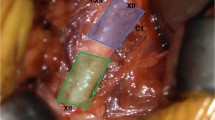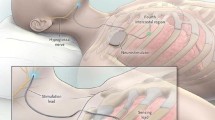Abstract
Purpose of Review
We proposed to describe hypoglossal nerve stimulation therapy of obstructive sleep apnea emphasizing the evidence for benefit and identifying patient selection factors foretelling of favorable outcomes.
Recent Findings
Hypoglossal nerve stimulation has proven to have lasting efficacy in the treatment of multiple aspects of obstructive sleep apnea including event frequency, nocturnal hypoxemia, sleepiness, patient quality of life, sleep architecture, and treatment adherence. Obstructive sleep apnea severity, pattern of pharyngeal collapse, weight, age, and previous surgery are cited predictors of hypoglossal nerve stimulation outcomes. Advances in science have honed the clinical and historical factors predictive of hypoglossal nerve stimulation therapy efficacy.
Summary
Positive airway pressure therapy is the primary therapeutic modality for sleep apnea. However, some subjects given positive airway pressure fail to accept or reliably adhere to treatment. Hypoglossal nerve stimulation therapy can be offered as alternative in such cases. Science has identified clinical features predictive of efficacy.
Similar content being viewed by others
References
Young T, Palta M, Dempsey J. The occurrence of sleep-disordered breathing among middle aged adults. N Engl J Med. 1993;328:1230–5.
Yaggi H, Concato J, Keman W, Lichtman J, Brass L, Mohsenin V. Obstructive sleep apnea as a risk factor for stroke and death. N Engl J Med. 2005;353:2034–41.
Shahar E, WHitney C, Redline S, Samet J. Sleep-disordered breathing and cardiovascular disease: cross-sectional results of the results of the sleep heart health study. Am J Respir Crit Care Med. 2001;163(1):19–25.
Eckert D, White D, Jordan A, Malhorta A, Wellman A. Defining phenotypic causes of obstructive sleep apnea. Am J Respir Crit Care Med. 2013;188:996–1004.
Edwards B, Wellman A, Sands S, Owens R, Malhotra A. Obstructive sleep apnea in older adults os a distinctly different pathological phenotype. Sleep. 2014;37(7):1227–36.
Weaver TE, Grunstein RR. Adherence to Continuous Positive Airway Pressure Therapy The Challenge to Effective Treatment 2008, https://doi.org/10.1513/pats.200708-119MG.
Weaver TE, Faan RN, Sawyer AM. Adherence to Continuous Positive Airway Pressure Treatment for Obstructive Sleep Apnea: Implications for Future Interventions.
Strollo PJ, Soose RJ, Maurer JT, et al. Upper-airway stimulation for obstructive sleep apnea. N Engl J Med. 2014;370(2):139–49. https://doi.org/10.1056/NEJMoa1308659.
Decker M, Haaga J, Arnold J, Atzberger D, Strohol K. Functional electrical stimulation and respiration during sleep. J Appl Physiol. 1993;75(3):1053–61.
Edmonds L, Daniels B, Stanson A, Sheedy PI, Shepards J. The effects of transcutaneous electrical stimulation during wakefulness and sleep in partients with obstructive sleep apnea. Am Rev Respir Dis. 1992;146(4):1030–6.
Guilleminault C, Powell N, Bowman B, Stoohs R. The effect of electrical stimulation during sleep on upper airway patency in patients with obstructive sleep apnea. Chest. 1995;107(1):67–73.
Van de Heyning P, Badr S, Baskin J. Implanted upper airway stimulation device for obstructive sleep apnea. Laryngoscope. 2012;122:1626–33.
Steffen A, Sommer JU, Hofauer B, Maurer JT, Hasselbacher K, Heiser C. Outcome after one year of upper airway stimulation for obstructive sleep apnea in a multicenter German post-market study. Laryngoscope. 2017;128(2):509–15.
Bohorquez D, Mahmoud A, Yu J, Thaler E. Upper airway stimulation therapy and sleep architecture in patients with obstructive sleep apnea. Laryngoscope. 2019.
Sarber K, Chang K, Epperson M. Hypoglossal nerve stimulation in veterans with obstructive sleep apnea. Laryngoscope. 2019.
Woodson B, Strohl K, Soose R. Upper airway stimulation for obstructive sleep apnea: 5-year outcomes. Otolaryngol Head Neck Surg. 2018;159(1):194–202.
Huntley C, Kaffenberger T, Doghramji K, Soose R, Boon M. Upper airway stimulation for treatment of obstructive sleep apnea: an evaluation and comparison of outcomes at two academic centers. J Clin Sleep Med. 2017;13(9):1075–9. https://doi.org/10.5664/jcsm.6726.
Bon M, Huntley C, Steffen A, et al. Upper airway stimulation for obstructive sleep apnea: results from the ADHERE registry. Otolaryngol Head Neck Surg. 2018;159(2):379–85.
Woodson B, Soose R, Gillespie MB, et al. Three-year outcomes of cranial nerve stimulation for obstructive sleep apnea: the STAR trial. Otolaryngol Head Neck Surg. 2016;154:181–8.
Kezirian EJ, Hohenhorst W, De Vries N. Drug-induced sleep endoscopy: the VOTE classification. Eur Arch Oto-Rhino-Laryngology. 2011;268:1233–6. https://doi.org/10.1007/s00405-011-1633-8.
Ong A, Murphey A, Nguyen S. Efficacy of upper airway stimulation on collapse patterns observed during drug-induced sedation endoscopy. Otolaryngol Head Neck Surg. 2016;154(5):970–7.
Evans S, Richman J, Cho D-Y, Withrow K. Increasing preoperative apnea severity improves upper airway stimulation response in OSA treatment. Laryngoscope. 2020;130(2):556–60.
Heiser C, Steffen A, Boon M. Post-approval upper airway stimulation predictors of treatment effectiveness in the ADHERE registry. Eur Respir J. 2019;53(1).
Huntley C, Steffen A, Doghramji K, Hofauer B, Heiser C, Boon M. Upper airway stimulation in patients with obstructive sleep apnea and an elevated body mass index: a multi-institutional review. Laryngoscope. 2018;128(10):2425–8.
Withrow K, Evans S, Harwick J, Kezirian E, Strollo P. Upper airway stimulation response in older adults with moderate to severe obstructive sleep apnea. Otolaryngol - Head Neck Surg (United States). 2019;161(4):714–9. https://doi.org/10.1177/0194599819848709.
Kezirian EJ, Heiser C, Steffen A, Boon M, Hofauer B, Doghramji K, et al. Previous surgery and hypoglossal nerve stimulation for obstructive sleep apnea. Otolaryngol - Head Neck Surg (United States). 2019;161(5):897–903. https://doi.org/10.1177/0194599819856339.
Huntley C, Vasconcellos A, Doghramji K, Hofauer B, Heiser C, Boon M. Upper airway stimulation in patients who have undergone unsuccessful prior palate surgery: an initial evaluation. Otolaryngol - Head Neck Surg (United States). 2018;159(5):938–40. https://doi.org/10.1177/0194599818792191.
Mahmoud A, Thaler E. Upper airway stimulation therapy and prior airway surgery for obstructive sleep apnea. Laryngoscope. 2017;128(6):1486–9.
Parikh V, Thaler E, Kato M. Early feasibility of hypoglossal nerve upper airway stimulator in patients with cardiac implantable electronic devices and continuous positive airway pressure-intolerant severe obstructive sleep apnea. Hear Rythm. 2018;15(8):1165–70.
Safiruddin F, Vanderveken OM, De Vries N, et al. Effect of upper-airway stimulation for obstructive sleep apnoea on airway dimensions. Eur Respir J. 2015;45(1):129–38. https://doi.org/10.1183/09031936.00059414.
Mahmoud AF, Thaler ER. Outcomes of hypoglossal nerve upper airway stimulation among patients with isolated retropalatal collapse. Otolaryngol - Head Neck Surg (United States). 2019;160(6):1124–9. https://doi.org/10.1177/0194599819835186.
Sturm J, Modik O, Suurna M. Neurophysiological monitoring of tongue muscle activation during hypoglossal nerve stimulation. Laryngoscope. 2019.
Steffen A, Kilic A, Konig I, Suurna M, Hofauer B, Heiser C. Tongue motion variability with changes of upper airway stimulation electrode configuration and effects on treatment outcomes. Laryngoscope. 2018;128(8):1970–6.
Heiser C, Maurer JT, Steffen A. Functional outcome of tongue motions with selective hypoglossal nerve stimulation in patients with obstructive sleep apnea. Sleep Breath. 2016;20(2):553–60. https://doi.org/10.1007/s11325-015-1237-4.
Kumar A, Vasconcellos A, Boon M, Huntley C. Inclusion of the first cervical nerve does not influence outcomes in upper airway stimulation for treatment of obstructive sleep apnea. Laryngoscope. 2019
Irvine L, Yang Z, Kezirian E, et al. Hyoepiglottic ligamentcollagen and elastin fiber compositionand changes associated with aging. Laryngoscope. 2018;128:1245–8.
Heiser C, Edenharter G, Bas M, Wirth M, Hofauer B. Palatoglossus coupling in selective upper airway stimulation. Laryngoscope. 2017;127(10):378–83.
Liu SYC, Wayne Riley R, Pogrel A, Guilleminault C. Sleep surgery in the era of precision medicine. Atlas Oral Maxillofac Surg Clin North Am. 2019;27(1):1–5.
Liu SYC, Hutz MJ, Poomkonsarn S, Chang CP, Awad M, Capasso R. Palatopharyngoplasty resolves concentric collapse in patients ineligible for upper airway stimulation. Laryngoscope. 2020.
Author information
Authors and Affiliations
Contributions
All authors met the four criteria for authorship established by the International Committee of Medical Journal Editors: Carlos Torre, Elie Alam, Alejandro Chediak, and Alexandre Abreu were responsible for the conception, design, and drafting the work, revising the work, and reviewing the manuscript. All authors provided final approval of the version to be published and agreed to be accountable for all aspects of the work in ensuring including the accuracy and/or integrity of the work.
Corresponding author
Ethics declarations
Conflict of Interest
None.
Human and Animal Rights and Informed Consent
This article does not contain any studies with human or animal subjects performed by any of the authors.
Additional information
Publisher’s Note
Springer Nature remains neutral with regard to jurisdictional claims in published maps and institutional affiliations.
This article is part of the Topical Collection on Sleeping and Breathing
Rights and permissions
About this article
Cite this article
Torre, C., Alam, E., Abreu, A. et al. Upper Airway Stimulation for Treatment of Obstructive Sleep Apnea. Curr Pulmonol Rep 10, 40–45 (2021). https://doi.org/10.1007/s13665-020-00264-w
Accepted:
Published:
Issue Date:
DOI: https://doi.org/10.1007/s13665-020-00264-w




